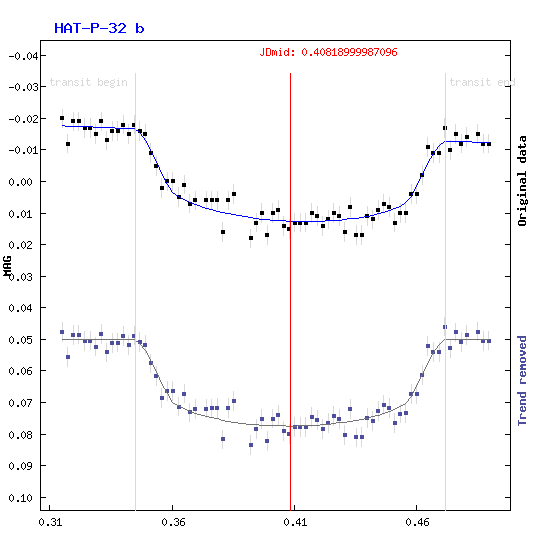HAT-P-32b orbits the bright star GSC 3281-00800 V = 11.289, with a period P = 2.150008 d. Stellar and planetary masses and radii depend on the eccentricity of the system, which is poorly limited due to the fluctuation of the high phase velocity (~80 m / s). Assuming a circular orbit, the star has a mass of 1.16 + -0.04 M_sun, and the radius of 1.22 + -0.02 R_sun, while the planet has a mass of 0.860 -0.164 + MJ, and a radius of 1.789 -0.025 + RJ.
When eccentricity is allowed to vary, the model results present a better fit on a planet that is close to its Roche Lobe result. Including the restriction that the planet cannot exceed the Roche results in the following parameters the best fit: e = 0.163 + -0.061, Pf = 0.94 + -0.17 MJ, Rp = 2.04 + -0.10 RJ, Ms = 1.18 + 0.04 to 0.07 M_sun and Rs = 1.39 + -0.07 R_sun.
Located approximately 1,044 light years from Earth. HAT-P-32b was first recognized as a possible planet by the HATNet Project in 2004, despite the impediments and difficulty in measuring its radial velocity astronomers verified the planet after three years of observation. The Blendanal program helped rule out most of the alternatives that could explain it was HAT-P-32b, leading astronomers to determine that HAT-P-32b was most likely a planet.
The planet is considered a hot Jupiter, and although it is slightly less massive than Jupiter, it is almost twice the size of Jupiter. At the time of its discovery, HAT-P-32b had one of the largest known radii among extrasolar planets. This phenomenon, which has also been observed on planets such as WASP-17b and HAT-P-33b, has been shown to influence why these planets become so large.
https://arxiv.org/abs/1106.1212







